 UK Royal Navy (1909-1922)
UK Royal Navy (1909-1922)1909 program, H-class 1913: HMS Acorn, Alarm, Brisk, Cameleon, Comet, Fury, Goldfinch, Hope, Larne, Lyra, Martin, Minstrel, Nemesis, Nereide, Nymphe, Redpole, Rifleman, Ruby, Sheldrake, Staunch
WW1 British Destroyers:
26 knotters | 27 knotters | 30 knotters | 33 knotters | Turbine destroyers | River class | Cricket class | Tribal class | Beagle class | Acorn class | Acheron class | Acasta class | L class | M class | Repeat M class | Medea class | Faulknor class FL | Marksman class FL | Parker class FL | Talisman class | Shakespeare class FL | R class | S class | Repeat R class | V class FL | Scott class FL | V class | W classIn short, the Acorn class (H class from 1913) were born frm the 1909-10 Programme as a reversion from coal (on the Beagle class) to oil fuel, and with the same speed specification based on a standard Admiralty design for the first time, trying to standardize the class for a larger production across more shipyards, receive more tenders. The admiralty design had three short funnels to reduce their silhouette at first, but the fore funnel was later raised during completion, and the armament was increased as well with new Mark 7 4-in guns forward and aft, and extra 12 pounders, some on the forecastle.
Twenty were built by eight shipyards, and overall, they were a net improvement over the previous Beagles. They had well trained crews when the war broke out, and saw heavy action until 1918, with three lost in action. Unusually, two were also leased to Japan to help with Mediterranean Operations. The Acorn class however had a relatively short career (10-11 years), as they were commissioned in 1910-11 and decommissioned in 1921, Washington Treaty obliges.
Development
Return to oil and better Armament
The coal-burning Beagle class of the 1908–1909 shipbuilding programme, caused by initial fears of the lack of oil, was soon reverted as it had many drawbacks over oil (plus the international situation changed), starting with volume versus energy efficience. The British Admiralty thus wanted to return to an oil-fuelled machinery, first pioneered in the 1905 Tribal class of 1905 and HMS Swift (1907). For this next tranche of the 1909–1910 programme, later named aftet the lead vessel, HMS Acorn, the smaller storage space (now oil tanks) made possible to built smaller, thus cheaper vessels compared to to the previous Beagles and more so the Tribals. The saved space was used for some structural improvements and allowed to increase the armament.
The first Admiralty Design
There was another great change marked by the Acorns, reconducted for all subsequent destroyers designs: Up to the Beagles, the Admirakty setup a rather loose specfications of armament, speed and propulsion specifics, with size and tonnage envelopes, whereas the detailed design was left to the builders. This was sound in order to get flexibility, so speed in construction for each yard, but resulted too often in a mixbag of standards withing each class, which was more difficult to manage as a result, since pairing for example destroyers having wide discrepancy of speed and range caused by diverging end specs inside squadrons complicated tactical training and planniong; The admiralty wanted to stop the individual ships differing between them as a rule.
For the first time the admiralty force the adoption of their own standard hull design worked with state engineers or private ones and the DNT (Directorate of Naval Construction) ending in a first “admiralty design”, which was approved in July 1909. This had some clearing effects too, alleviating the load of looking for sub-providers so to attract more shipyards bidding for orders,create extra competition and thus reduce costs even further, notably when saving the time and effort required for the Admiralty to check and approve each builder’s design.
What the admiraty define was the size, displacement, artillery, machinery arrangement, performances specs, peculiarities leaving only the detailed Machinery design to the discretion of builders, provided their turbines and boilers fit into the space allocated by this precise design. This was a new game, and yards had no choice but to accept it. The end result was that the admirakty was given a very homogeneous class with reasonably uniform appearance, three funnels with each a tall and thin fore funnel, short and thick central (twin truncation) and short narrow aft stack, but also in proportion from the forecastle to the poop shape. More importantly, Admirals now could count on sape speed, same range, same armament, same seaworthiness in operations.
Construction
Needless to say, this became a standard to have private proposals based on an “admiralty design” and yet, some yard went on to propose their own designs to the admiralty if they filled roles better. Both “systems” competed during the war in fact. In all, seven yards obtained contracts (far more than usual), namely:
John Brown and Company:
William Denny & Brothers:
Fairfield Shipbuilding & Engineering Company, Govan: Camaleon, Comet, Goldfinch
R. W. Hawthorn Leslie & Company:
Swan Hunter & Wigham Richardson:
A. & J. Inglis:
John I. Thornycroft & Company:
J. Samuel White & Company:
The next in line, the Acheron class (‘I’ class in 1913) followed theml for the 1910-11 program. They were very much a repeat, 20 ordered but 26 obtained (three in Australia), and were generally repeats of the preceding Acorn class, albeit Acheron and five ships were “builders’ specials”, private counter proposals the admiraty designs, notably those from Yarrow. They diverged from the Acorn class by having two funnels, short, but the foremost being thicker and the 12-pounder guns mounted slightly further forward. Based on the need for the admiralty to have a heavier armament, led to a 25% increase in displacement, producing the new Acasta class, very close to the 1000-tons mark for the first time. The British destroyer tree would even brounch out more in the following years with two more types, destroyer leaders and light destroyers obeying different roles better.
Design of the class
Hull and general design
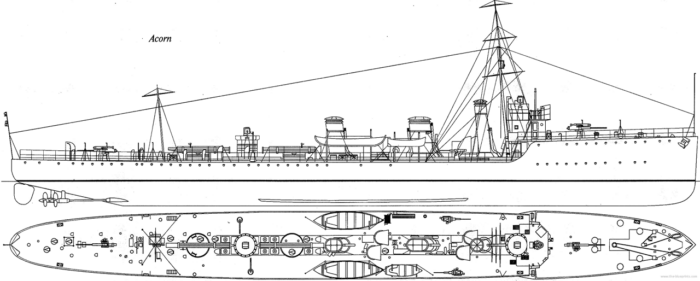
Acorn class, The blueprints
The Acorn class were smaller than the previous Beagles.
-Displacement was 760 long tons (770 t) normal and 855 long tons (869 t) full load indeed versus 860–940 long tons.
-They were 240 feet (73.15 m) long between perpendiculars and 246 feet (74.98 m) overall versus 275 ft (83.8 m) overall, so a reduction of 28 feets or 8.4 meters.
The beam was also reduced drastically from 27 ft 6 in (8.38 m) to 25 feet 3 inches (7.70 m) .
Draught on the Acorn class was comprised between 7 feet 4+1⁄2 inches (2.248 m) and 8 feet 10 inches (2.69 m) depending on load, versus 8 ft 6 in (2.59 m) on the Beagles, so comparable. This ratio also improved stability. Their seaworthiness was kept with only a slight reduction of deck height and forecastle. The shaped however were about the same, with fine entry lines and some reasonable sheer forward, same near-straight bow, rounded poop, rounded aft rudder and shafts struts attachements.
The Acorn class had a crew of 72 officers and ratings, wit two whalers under davits abaft the third funnel and a small cutter on the starboard side, close to the amdiship funnel. The proportions were the same with a forcastle having a graded deck up, 1/4 of the hull’s lenght, and the bridge moved back, mid-way between the forecastle’s end and lower deck. There was a tall mainmast, smaller pole aft mast aft of the second torpedo tube. There was the same low structure on the main deck supporting the base of all three unequal size, unheavenly spaced funnels and two pairs of echeloned air intakes, two smaller ones aft of the last funnel and many peppered on the deck, plus access hatches close to the fore torpedo tube. The funnels were very unique to this class, with the single, small and round almost pipe like forefunnel right after the bridge, long and lower second funnel, and amidship aft funnel, still not round but shorter. They had caps as well.
The ships were equipped with two projectors on platforms which sat forward on top of the bridge and another between torpedo tubes. There was a spotting top accessible via the metallice latter on the two parts composed mainmast.
Unlike the Beagles, the forecastle gun was not raised on a bandstand, as it was believed to generate in heavy seas even more generated additional spray.
The main bridge was fully open, protected by man-high canvas but no roof. The cabin below was the map table. There was a backup steering wheel behind the aft mast with voice pipes. The chadburn, voice pipes, repeater, other indicators and the flag stowage bin were all on the open bridge. The funnels and masts were raked, as common practice. Tail lights were anchored on a tripod pole at the poop, with another stright one at the bow.
Powerplant
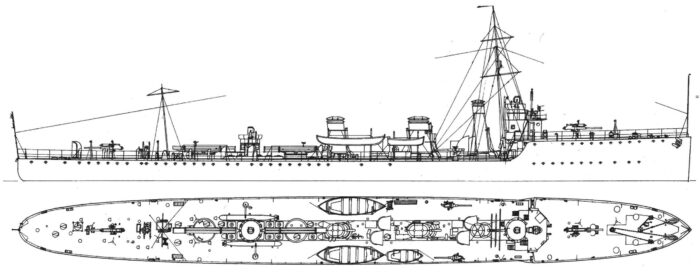
HMS Larne plans (Kombrig)
19 of the 20 ships in class had three propeller shafts, driven by Parsons steam turbines and fed by four boilers they can be either White-Forster boilers for the White ships, Redpole, Rifleman and Ruby, and Yarrow boilers in the remainder. The boiler out-takes were routed to three funnels with the central boiulers truncated into a longer amidship funnel. The remaining ship by John Brown & HMS Brisk was the only with two shaft and powered by Brown-Curtis impulse turbines instead of Parsons.
They were contracted for 27 knots (50 km/h; 31 mph) top speed just like the Beagle class, yet being smaller, and for that, the peak power was expected to be 13,500 shaft horsepower (10,100 kW) compared to their size. This implied many calculations to feet the powerplant.
So in resume, those with the recommended admiralty setup were HMS Cameleon, Comet, Acorn, Goldfinch, Nemesis, Larne, Alarm, Hope, Nereide, Lyra, Staunch, Martin, Sheldrake, Nymphe, Minstrel, Fury with three three Parsons steam turbines and four Yarrow boilers, whereas Redpole, Rifleman and Ruby had three Parsons steam turbines and four White-Forster boilers. HMS Brisk had two Brown-Curtis steam turbines and four Yarrow boilers.
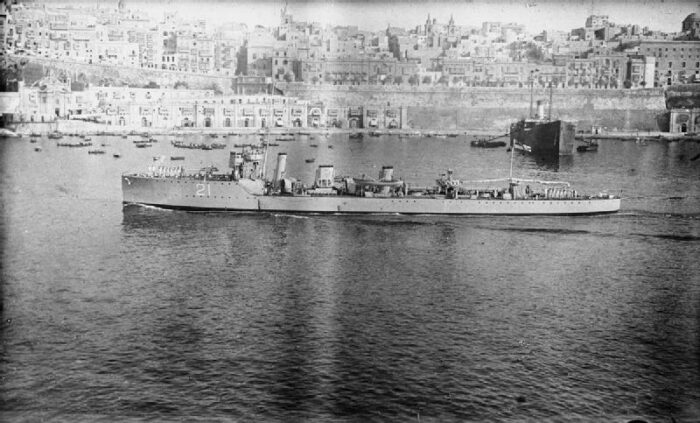
HMS Cameleon in the Mediterranean
Armament
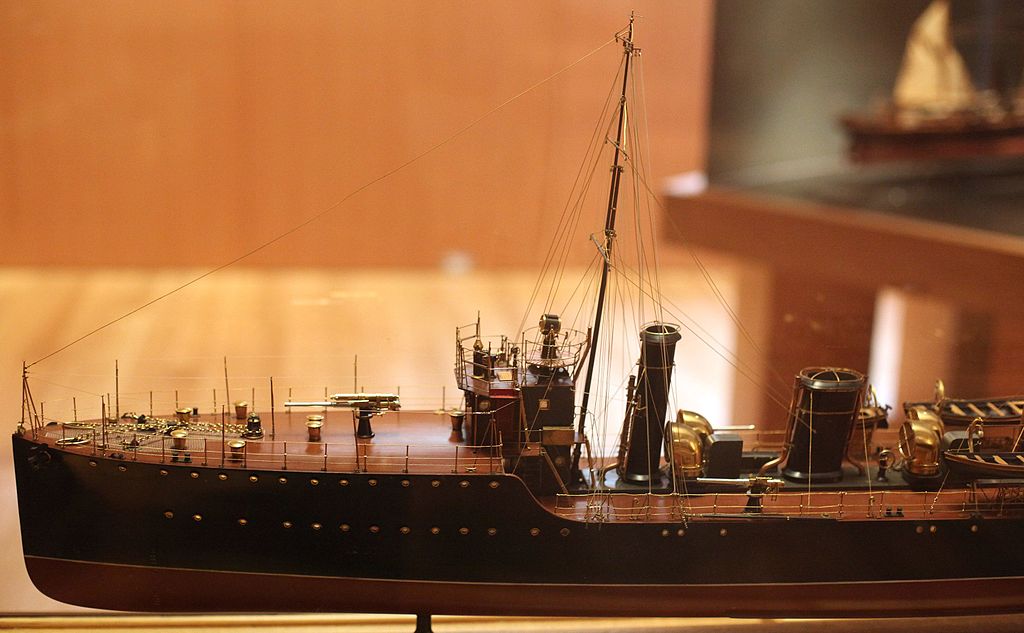
HMS Hope’s forecastle, yard model.
The revised machinery layout freed up deck space. So the admiralty wanted heavier armament compared to the Beagles, and it was chosen to install two 4-inch (102 mm) BL Mk VIII guns, one on the forecastle, another aft, plus two 12-pounder (76 mm) QF 12 cwt guns on the waist, between the first two funnels and echeloned to fire cross deck if needed.
The conversative torpedo armament still comprised two 21-inch (533 mm) torpedo tubes in axis and with two reload torpedoes. Only change was that the tubes were longer and allowed for more modern torpedoes (see below). The torpedo tubes were located aft of the funnels with the searchlight post between them.
In wartime they receive a 3-pounder (47 mm) Vickers anti-aircraft gun as well as depth charge racks and in some case, Y-guns (see below).
4-in Mark VIII/40 (101.6 mm)
These were designed in 1908 and entered service on the HMS Swift, Tribals, Beagle and Acorns.
⚙ specifications 4-in Mark VIII |
|
| Weight | 2,912 pounds (1,320 kg) |
| Barrel lenght | 159.2 inches (4.044 m) bore 40 calibres |
| Elevation/Traverse | -10° to +20°, 360 |
| Loading system | Welin single-motion screw breech |
| Muzzle velocity | 2,287 feet per second (697 m/s) |
| Range | 10,210 yards (9,340 m) |
| Crew | 8 |
| Round | 31 pds (14.06 kg) Common lyddite |
| Rate of Fire | 6-8 RPM |
QF 12-Pdr 12 cwt
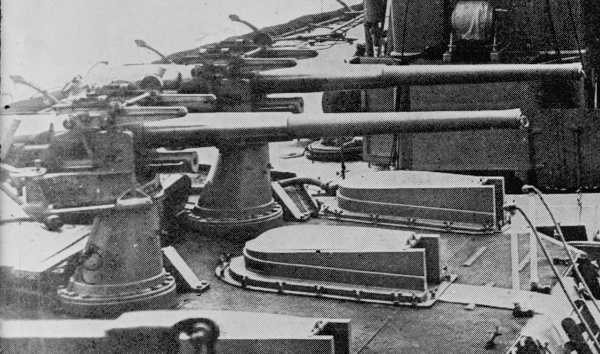
The QF 12 pounder 18 cwt gun (Quick-Firing) was a 3-inch high-velocity naval gun intended at first for battleships to deal with torpedo boats. 18 cwt referred 112 lbx2,016 lb or 914 kg unlike the strick “12 pounder” with was actually 12.5 lb or 5.7 kg. They ended on a lot of capital ships.
They had P. V mountings with 100 rounds per gun just as the “Tribal” group., capable of +20° and -10° which was important to deal with submarines close.
Sights were cam-worked with range dials for 2150 fps also used as .303-in aiming rifles elevating the same, with graduations ending at 19.25° or 8100 yards full charge. Deflection gearing was constant at 43.76, 1 knot= 3.76 arc minutes, for a muzzle velocity of 2197 fps at 2000 yards.
The drift was corrected by inclining the sight 2 degrees with left sights 10.25 inches above the bore, 10 inches left. But the sight could be also used as free sight, with an open sights for the layer. There was no temperature corrector however.
In late 1913, these gun mountings started to receive percussion firing gears.
⚙ specifications 12-pdr, 12 Cwt |
|
| Weight | 2,016 lb (914 kg) |
| Barrel lenght | 150-inch (3.81 m) 50 calibres |
| Elevation/Traverse | |
| Loading system | |
| Muzzle velocity | 2,600 ft/s (790 m/s) |
| Range | 9,300 yards @ +20° (8,500 m @ +20°) |
| Crew | 5 |
| Round | Separate QF 12.5 lb (5.66 kg) |
| Rate of Fire | 20 rd/min |
21-in Torpedoes
The new RGF Mk II 21-in torpedo with the Hardcastle heater was adopted in this class. It ran at 5Okts (93 km/h; 58 mph) over 1000yds (910 m) or 12,000yds (11,000 m) at 30kts (56 km/h; 35 mph). Two spare torpedoes were carried. Instead of the “Short” Mark I they carried the “Long” Mark I at 23 ft 1.25 in (7.042 m) thanks to their longer tubes and then the Mark II. The Mark I long explosive charge was 200 lb (91 kg) of gun cotton, increased later to 225 lb (102 kg). The spare torpedoes were stowed either side at the foot of the searchlight platform on deck.
But the bead and breakfast of these ships in WWI was their Mark II introduced in 1914:
⚙ specs Mark II TORPEDO |
|
| Weight | 1,6t |
| Dimensions | Diameter 534 mm, Length 681 cm |
| Propulsion | Wet Heater |
| Range/speed setting | 5,500 yards (5,000 m)/30 knots |
| Warhead | 280 lbs. (127 kg) wet gun-cotton |
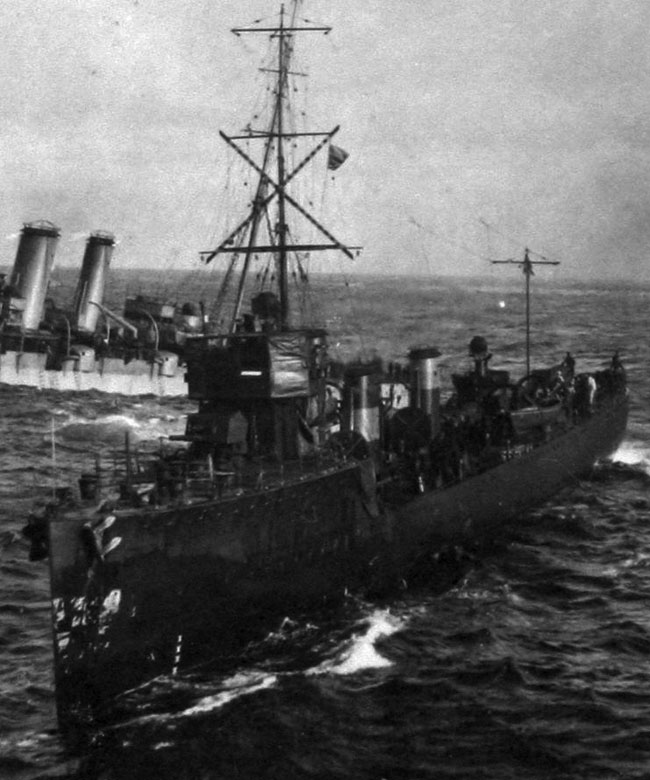
HMS Fury in 1911, attending HMS Audacious
Depth Charges
In July 1912, HMS Alarm was the first fitted for trials of an explosive sweep mated with electrically-fired charge. In May 1918, Nymphe combined a sweep gear with two depth charge throwers (Y-guns) and four stern chutes, 12 charges. In August, 1918, HMS Brisk was equipped with the standard, two depth charge throwers (DCT or Y guns) eight spares, one ‘runner” with 23 charges. They no longer carried Paravanes to compensate for this 7.5 tons increase and some even had to land their aft 4-in gun.
Fire Control
By 1915 fixed voice pipes were added between decks ending with flexible mouths, one for gunnery, one for torpedoes and linking the bridge with the guns, torpedo tubes and searchlights stations. There was a third fully flexible voicepipe from bridge to the forward gun to pass informations.
The Acorns had a one meter base rangefinder, supplied to all destroyers of the “Tribal” class and delivered up to the “L” class of 1916.
In 1920 destroyers from the Acorn to Laforey classes had Wise Pressure Telegraphy Systems in place, in support of the fire control.
The main sighting position located high up in the centre of the bridge used a single set of firing pushes/keys and keys for operating a buzzer lighting at the forward torpedo mount and rattler at the aft mount. Data instruments were electrical with a Mark I deflection transmitter from the control post, separate order transmitters and keys (forward tube, aft tube) with each mount had having a combined receiver for these electric signals.
⚙ specifications |
|
| Displacement | 730 to 780 tons standard, c850t FL |
| Dimensions | 246 ft 6 in x 25 ft 6 in x 7 ft (75.13 x 7.77 x 3 m) |
| Propulsion | 3 shafts steam turbines, 3 oil-fired boilers 13,500 shp (10,067 kW) |
| Speed | 27 knots (50 km/h) |
| Range | 170 tons oil, c800 nm? |
| Armament | 2× BL 4-in/40 Mark VIII, 2× QF 12-pdr 12 cwt Mark I, 2× 21-in TTs |
| Crew | 72 |
Career of the Acorn class
 HMS Acorn
HMS Acorn

HMS Acorn was laid down at John Brown and Co., Clydebank on 12 January 1910, launched on 1 July 1910, completed on December 1910. She joined the 2nd Destroyer Flotilla (as most of her sisters) in the Home Fleet, and involved in a collision with HMS Redpole on 7 March 1911, was at the Coronation Fleet Review on 24 July 1911 but suffered problems when steaming at full speed off Ireland during in the 1911 Naval Manoeuvres with seawater leaking through hull rivets and into the oil tanks. They were all repaired at Portland.
By August 1914 the unit operated with the Grand Fleet and by November 1915 she was transferred to the 5th Destroyer Flotilla, Mediterranean Fleet, proceeding to Malta on 31 December. With HMS Colne she tested hydrophones in 1917. She mistaken a US sub-chaser (SC-151) for an Austrian ship on 20 June 1918 in the Strait of Otranto, fired but missed. In November 1918 she was in the Aegean Squadron at Mudros, then was placed in reserve at Devonport by March 1919, Sold for BU on 29 November 1921.
 HMS Alarm
HMS Alarm
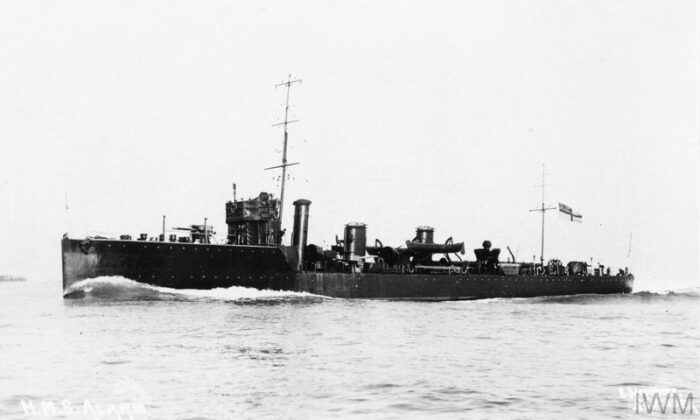
HMS Alarm was from John Brown and Company, laid down on 7 February 1910, launched on 29 August 1910 and completed on March 1911. 2nd Destroyer Flotilla, Home Fleet, had leaks issued on the coast of Ireland in 1911 Naval Manoeuvres, repaired in Portland. On 26 January 1912 she was fitted with anti-submarine sweeps for trials. Still 2nd Flotilla by August 1914, Grand Fleet, Scapa Flow. 16 October 1914 saw her, with sisters Lyra, Nymphe, Nemesis patrolling the eastern end of the Pentland Firth (Orkney-Scotland) when at 1:15 pm Nymphe spotted a periscope, U-9, which just sank the British cruiser Hawke. She fired a torpedo on them, narrowly missed both Nymphe and Alarm, and Nymphe tried to rame her bu she made a dive and escaped.
The 2nd Flotilla remained at Scapa Flow until March 1916. In April they moved to Devonport naval base, Plymouth. 13 November 1916 Alarm was sent to escort the transport Idaho to Portland from New York with explosives. Fog delayed her and Idaho was attacked surfaced by U-49, the crew abandonded her but Tigress arrived and drove off U-49. On 22 March 1917, Alarm and Tigress escorted the battleship HMS Duncan. On 24 March 1917, Alarm rescued 11 survivors from Achille Adam sunk by UB-39.
In July 1917, she was moved to Buncrana northern Ireland and in December she was ordered to the Mediterranean Fleet, 5th Destroyer Flotilla.
She took part in the Otranto barrage battle in the night of 22/23 April 1918, duelling woth the Triglav, Uzsok, Dukla, Lika and Csepel, later breaking off the pursuit close to the enemy coast.
After the end of the war she was laid up into reserve at Portsmouth by March 1919, sold on 9 May 1921.
 HMS Brisk
HMS Brisk
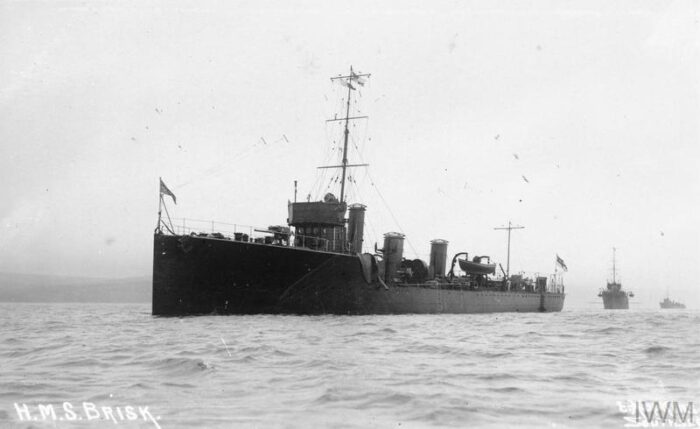
HMS Brisk was laid down at John Brown and Company, Clydebank, laid down on 21 February 1910, launched on 20 September 1910 and completed June 1911. In short: 2nd Destroyer Flotilla, Grand Fleet 1914, Devonport for escort duties. ASW patrols north sea. November 1915, English Channel with the 4th Destroyer Flotilla and another from Portsmouth. Next she was used for escorts, like on 31 January 1917, with SS Calgarian to Halifax with British gold, 22 March she escorted HMS Prince of Wales. On 21 February she escorted SS Mendi off the coast of the Isle of Wight when SS Darro appeared out of the fog and struck Mendi whuch sank, so she rescued survivors (647 died). On 18 April, SS Frankier was approached by U-84, which fired a torpedo, missed, Brisk rushed but the UBoat had the time to dive. On 29 May SS Oswego was torpedoed by U-88 before the destroyer arrived, and shew as recuing survivors when signalled SS Ashleaf was also attacked, and she was in time to see a periscope, thwoing depth charges, driving the submarine away. On 2 October, she escorted the damaged armoured cruiser Drake, when hitting a mine. She was towed back to port by trawlers.
In 1918, Brisk was transferred to the Aegean Squadron with her sisters. In June she was rearmed. 15 October 1919 she was decommissioned, in reserve at Devonport, sold for breaking up 15 November 1921.
 HMS Cameleon
HMS Cameleon
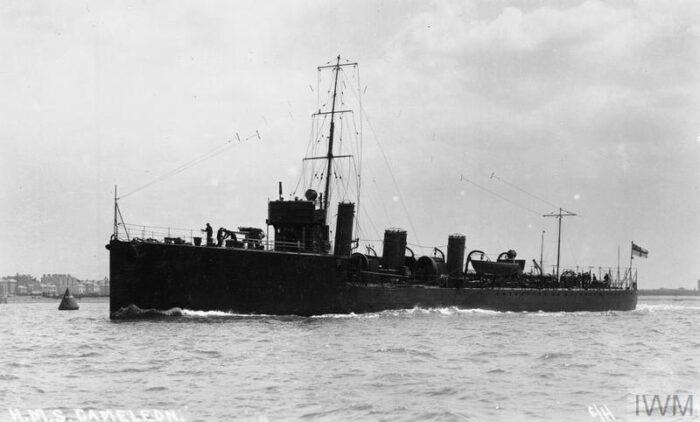
Cameleon was laid down at Fairfield Shipbuilding & Engineering Company in Govan on 6 December 1909, launched on 2 June 1910 and completed on December 1910. No published records. She was sold for BU 15 November 1921.
 HMS Comet
HMS Comet
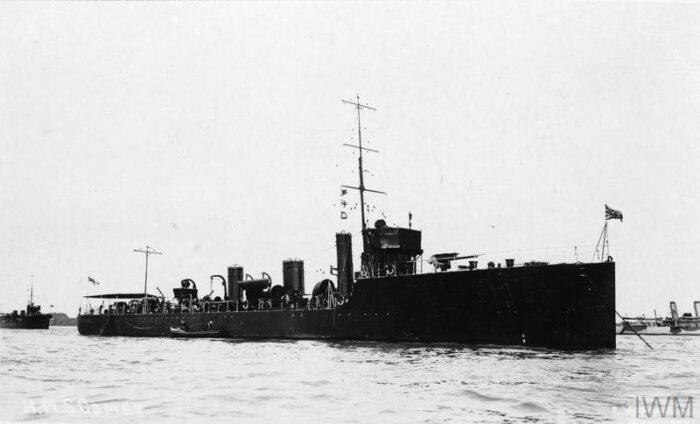
Comet was born in Fairfield Shipbuilding & Engineering Company in Govan, laid down on 1 February 1910, launched on 23 June 1910 and completed by June 1911. She was torpedoed and sunk by an Austrian U-boat in the Mediterranean on 6 August 1918. No more records.
 HMS Fury
HMS Fury
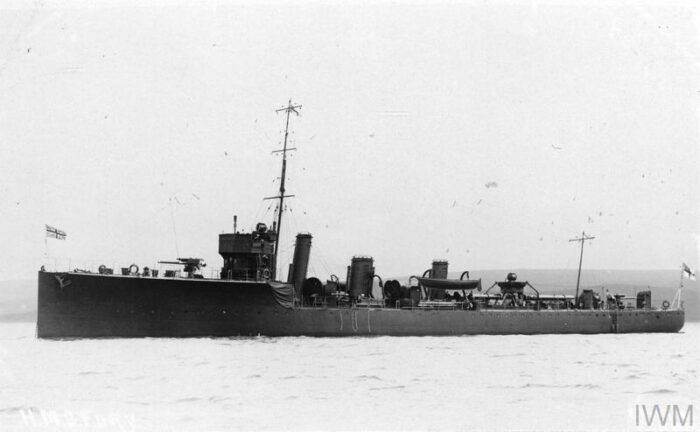
Fury was built at A. & J. Inglis, Pointhouse, Glasgow, laid down on 3 March 1910, launched on 25 April 1911 and commissioned on February 1912. 2nd Destroyer Flotilla, Grand Fleet based, Scapa Flow aug. 1914. She attended the battleship Audacious after she struck a naval mine on 27 October. She escorted the ocean liner Olympic, light cruiser Liverpool and Thornhill that all trie to tow her, each time they snapped. On 8 August 1915, she was in ASW patrol under Admiral Bayly south Ireland.
She was transferred to the 5th Destroyer Flotilla, Mediterranean and stayed there until of the war, escorting convoys and patrolling the Otranto Barrage. She sailed on 20 January 1918 for Britain and a refit. In 1919 she was in reserve at Devonport but like all her sisters, with the harsh conditions of wartime operations, high speed, poor weather battering, a not galvanised hull and shakly rivets, leakages, and engines workong at full capacity at all times, she was completely worn out after ten years, and sold for breaking up 4 November 1921.
 HMS Goldfish
HMS Goldfish
no pic
HMS Goldfinch was laid down at Fairfield Shipbuilding & Engineering Co. in Govan, laid down on 23 February 1910, launched on 12 July 1910 and commissioned on February 1911. 2nd Destroyer Flotilla. Night of 11 March 1911, a fire broke out in her radio room while at Devonport. In August 1914, Grand Fleet, escorts and she ran aground on Start Point, Sanday (Orkney Islands) in fog on the night of 18/19 February 1915. Wrecked, her remains were sold for scrap in 1919.
 HMS Hope
HMS Hope
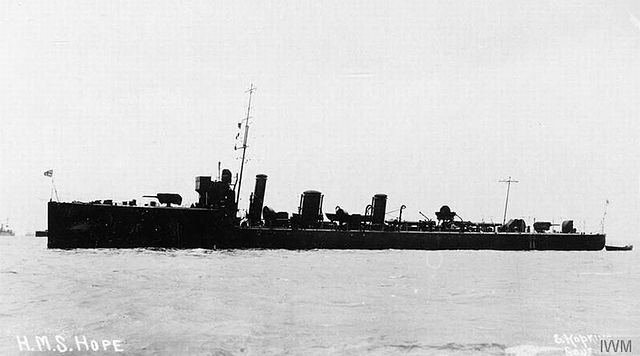
Hope was laid down at Swan Hunter & Wigham Richardson, Wallsend on 9 December 1909, launched 6 September 1910, completed in March 1911. 2nd Destroyer Flotilla. 22 March 1913 she was being fuelled at Cromarty when a fire started (5 injured). August 1914, Grand Fleet, Devonport for escorts. 30 July 1915, escorted RMS Aquitania to the Mediterranean, SS Commodore on Liverpool-Dublin every night. 5 March 1916 rescued crew of SS Rothesay. 3 December 1916 detached to Dover. 23 January 1917 rescued crew Dutch SS Salland sunk by SM U-53. Transferred to 5fth DF Mediterranean Fleet, tender HMS Blenheim. 20 January 1918, attached to the Aegean Squadron in Malta. Collided with the destroyer HMS Arno on 23 March, latter sunk.
Paid off in 1919, sold for breaking up at Malta in February 1920.
 HMS Larne
HMS Larne
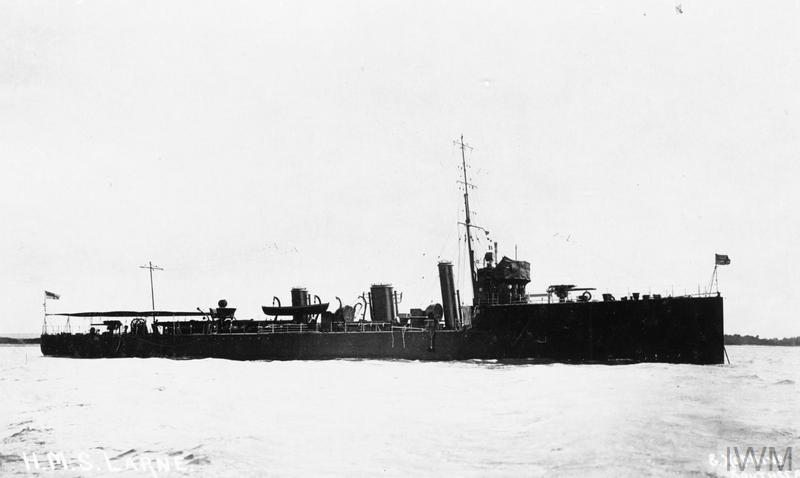
HMS Larne was laid down at John I. Thornycroft & Company, Woolston on 8 December 1909, launched on 23 August 1910 and completed on February 1911. 2nd Destroyer Flotilla, 8 August 1911 fleet exercise in the Irish Sea, damage with leaking rivets. 9 July 1912 naval demonstration by Winston Churchill, to the Parliament. August 1914, Devonport for escort duties. Patrolled Loch Ròg andOuter Hebrides on 12-13 November with HMS Rifleman. 2 February was with Cameleon in Barrow-in-Furness for ASW patrols, flag HMS Conqueror. She escorted her to Liverpool on 14 February, then Scapa Flow. Badly damaged at Greenock. 14 February 1916, recommissioned at Devonport. 28 April while off Devonport shot at a surfaced submarine at long range, lilely U-45, she escaped. 9 September, rescued crew from Pronto. 1917, transferred to the Mediterranean, Brindisi. Aegean Squadron from 20 January 1918. Decommissioned 1919, reserve at Devonport, sold for BU Thos. W. Ward 9 May 1921.
 HMS Lyra
HMS Lyra
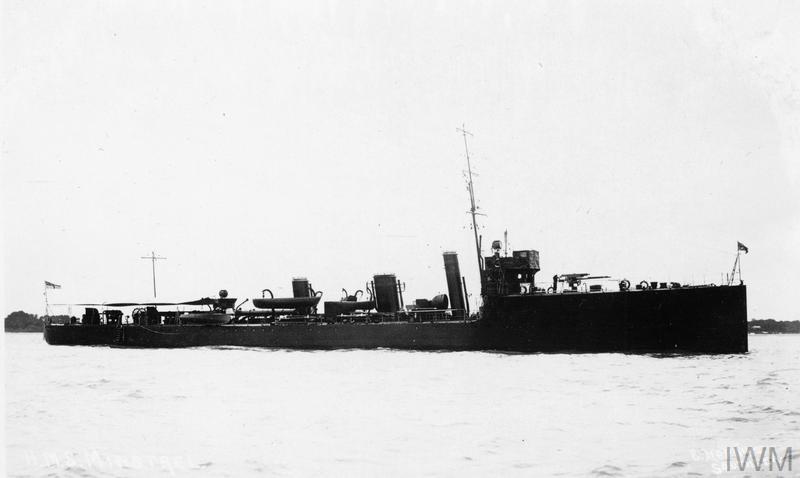
Lyra was from John I. Thornycroft & Company, Woolston, laid down 8 December 1909, launched 4 October 1910, completed February 1911. 2nd Destroyer Flotilla February 1911, replacing Garry. 7 April 1911, ran aground west Gairsay, Orkney, no damage. 8 August 1911 fleet exercise in the Irish Sea, same as above. August 1914 Grand Fleet, Devonport. 16 October, leading her flotilla when U-17 was sighted, after just sinking the protected cruiser Hawke and approach to torpedo Lyra and Nymphe. She escaped.
3 December 1916, escorted troopships to Liverpool. 17 January 1917, escorted ships for Sierra Leone. 22 January, rescued merchant ship SS Bendoran atacked by U-57 from Hong Kong. Iinjured in a friendly fire incident by Bendoran. Rescued the Japanese Prince, sunk by UC-47 on 10 February. 7 July, rescued SS Bellucia torpedoed by UB-31. 7 August, drove away U-44 closing on SS Orama.
Transferred to the Mediterranean, Gibraltar in 1918, patrolled the barrage vs U-Boat trying to sneak in. 8 November, spotted one and engaged, but she escaped. Decommissioned 1919, reserve at Portsmouth, sold for breaking up 9 May 1921.
 HMS Martin
HMS Martin

Martin was from John I. Thornycroft & Company, Woolston, laid down 21 December 1909, launched 15 December 1910, completed March 1911. 2nd Destroyer Flotilla, Grand Fleet 1914. 13-15 October 1915 escorted battleships of the Grand Fleet in training. 8 November 1916 with Brisk and Acasta-class HMS Unity, left Devonport for ASW patrols. Deployed to Dover, 3 December with Hope, called to patrlled the English Channel and Strait of Dover. Relocated western coast of Britain.
From January 1917, escorted merchants off the Isles of Scilly. 19 February escorted SS Headley, attacked by U-60. dropped depth charges, reported damage. 7 August, sailed out Lough Swilly to join a convoy when periscope sighted, port side. She attacked joined by Ruby and three other destroyers. U-44 or U-69 escaped. 2 October escortedthe crippled armoured cruiser Drake but she capsized and she rescued her crew with the sloop Delphinium. 1918, Mediterranean Fleet, Brindisi. Decom. 1919, sold for breaking up 21 August 1920 at Malta.
 HMS Minstrel
HMS Minstrel
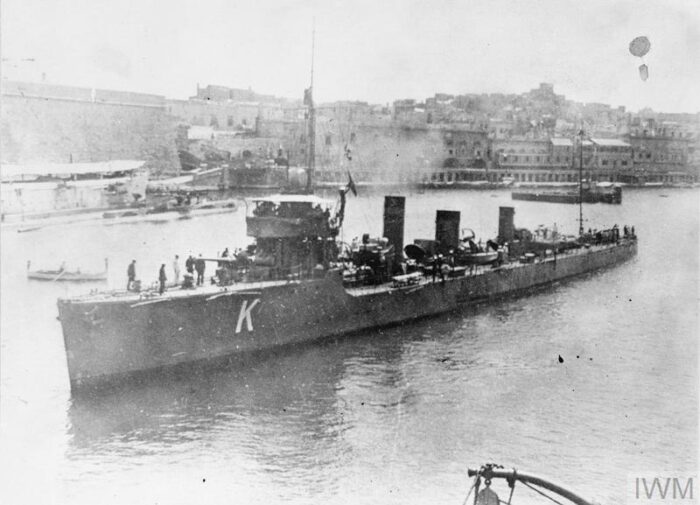
Minstrel was from Thornycroft, laid down 11 March 1910, launched 2 February 1911, completed May 1911. 20 July when detached on passage from Cromarty to Portland she proceed alone to Southampton, when runnin aground off Langston Bar. Ccommanding officer William G. A. Kennedy was court martialed while sailing at 18 knots with poor navigation skills.
August 1914, 2nd Destroyer Flotilla Grand Fleet. Experienced steering gear issues winter 1914–15. December 1915, 5th Destroyer Flotilla Mediterranean, escorting troop transports to Malta.
She was loaned to the IJN from June 1917 to 1919 as Sendan, 2nd Special Squadron and assigned to the Sasebo Naval District on 19 November with Kanran, ex HMS Nemesis bu as part of the Malta Flotilla, British Mediterranean Fleet and under Japanese ensign, manned by Japanese crew in January 1918. Released 17 January 1919, returned to RN at Plymouth, sold for breaking up 1 December 1921.
 HMS Nemesis
HMS Nemesis
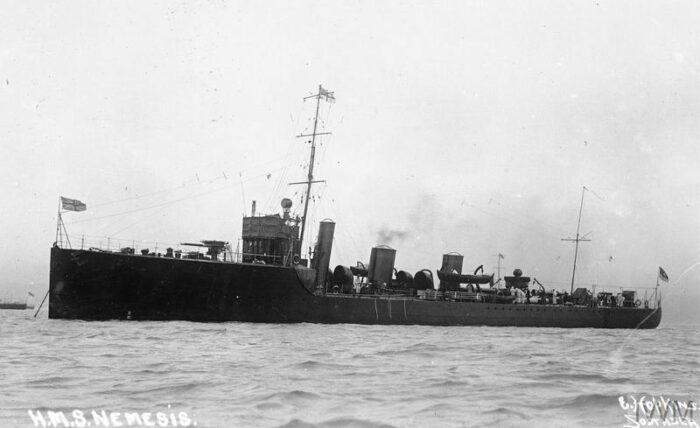
HMS Nemesis was from R. W. Hawthorn Leslie, laid down 24 November 1911, launched 9 August 1910 and completed on March 1911 but delayed by a 13 week stoppage during construction (labour troubles). 2nd Destroyer Flotilla, Grand Fleet, Scapa Flow. 16 October wile off Pentland Firth, she was attacked by U-9, missed by 200 yd (180 metres) from her bow. She escaped. 16 March 1915, damaged in a collision with Nymphe in exercise, coast of Scotland. 6 May, damaged in a collision with minelayer Orvieto. 13-15 October escorted battleships Grand Fleet for practice cruise. Detached for extensive escort duties until December 1916.
1917, assigned to the Adriatic Squadron; Mediterranean Fleet. 26 May with Cameleon, escorted the hospital ships Dover Castle and Karapara between Malta and Gibraltar when attacked by UC-67, sinking Dover Castle. Smoke screen up, Karapara escaped to Annaba. Transferred to the IJN as Kanran, 11th Japanese Destroyer Division in the Mediterranean Sea, Gibraltar, escorting troop ships. Returned 17 January 1919, reserve Devonport, sold for breaking up 26 November 1921.
 HMS Nereide
HMS Nereide
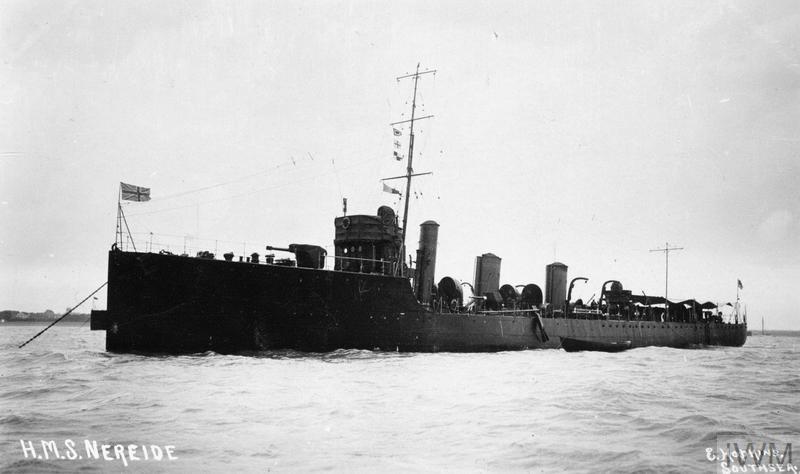
Nereide was from R. W. Hawthorn Leslie, laid down 3 December 1912, launched 6 September 1910, comp. March 1911. 2nd Destroyer Flotilla and from 6 September 1911, visited Campbeltown. August 1914, Grand Fleet. 13-15 October, supported battleships for practice cruise. Deployed to Devonport for escort duties until December 1916.
Assigned to the British Adriatic Squadron, Mediterranean Fleet in 1917. 20 January 1918, based at Gibraltar, ASW barrage patrols. 2 October, escort for the Bombardment fleet of Durazzo, led by San Giorgio. 26 November departed for Varna, Black Sea for joint UK/French/Italian operation. In Odessa provided sanctuary to Russian nobility, Countess Natalia Brasova and daughter Princess Vyazemskaya, brother-in-law Aleksei Matveev evacuated to Constantinople.
Post Armistice, decom. 1919, reserve at Devonport, sold for breaking up 1 December 1921.
 HMS Nymphe
HMS Nymphe
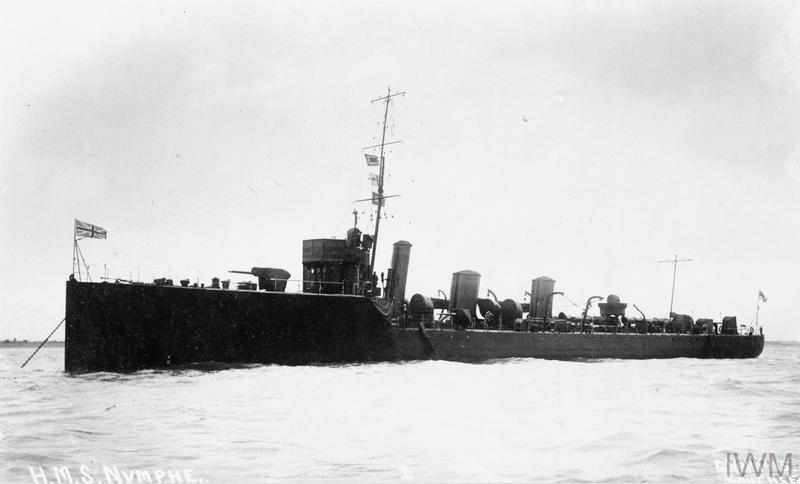
Nymphe was laid down at Hawthorn Leslie 8 December 1909, launched 31 January, completed 1911 May 1911. 2nd Destroyer Flotilla, 2nd Division Home Fleet. High-speed trials Atlantic off Berehaven in Ireland 1 July 1911, all achieved 28 knots in rough weather but suffered damage, leakaged repairs in Portsmouth 4 July 1911. 16 October 1911 her 6-pounder gun exploded while in night-firing exercises off Weymouth. Transferred to the First Fleet in 1912. Late April 1914 patrolled in Dundrum Bay (County Down, Ireland) to prevent weapons smugglers. Grand Fleet in August 1914.
10:30, 15 October 1914, U-9 torpedoed and sank HMS Hawke off Aberdeen, Scotland. Nymphe was on patrol, eastern approaches to Scapa Flow. At 13.30 Nymphe sighted U-9′s periscope, alerted other DDs, proceeded to ram U-9, failed and latter fired a torpedo, missed her bow by feets. While turning to make another pass, Nemesis forced Alarm to take evasive action.
She took part in the GF exercises on 15 March 1915 when colliding with Nemesis in poor weather.
March 1916, relocated to Portsmouth. May 1916 temporary tender to HMS Vernon Torpedo School. July-November Portsmouth Local Defence Flotilla. Night 7–8 December 1916 assisted SS Conch torpedoed by UB-23 off St Alban. She served with the Paravane Department at Portsmouth from January 1917 to February 1918, prfecting it as a weapon against submarines and mines. Still Portsmouth Escort Flotilla by January 1917 and Local Defence Flotilla June 1917. 17 May she defended the British steamer Florence Louise attacked by UB-40, stopped, ordered to abandon ship. Nymphe arrived and forced UB-40 to submerge. A few hours later, UB-40 again stopped she same ships and succeeded. Nymphe had an internal explosion in the Channel on 9 July 1917 (5 Kia).
She was tender for HMS Vernon March-April 191, reassigned later to the Mediterranean, 5th DF May 1918.
18 June 1918, friendly fire incident with HMS Defender, Strait of Otranto. USS SC-94, USS SC-151, USS SC-227 at 21:00, picked with hydrophones sounds from a, assumed submarine and proceeded at flank speed to find Nymphe and Defender, challenged both British destroyers with recognition signals using blinker light adn the latter did not respond, so they opened fire. Nymphe had a steam line ruptured, steam engines out of commission. Immediately flashed lights to cease fire, until identities were confirmed.Boats were sent, they discussed the incident later and British capitains said they had strict orders not to use recognition signals… Defender took Nymphe in tow for repairs but the incident was discussed in a letter to the British Admiralty by the European US Naval Forces, Vice Admiral William Sims deploring the incident. Fortunately, both destroyers had no casualties.
In July-August 1918 her Flotilla was relocated at Brindisi. 2 October 1918, she escorted the Allied bombardment of Durazzo, southern flank with US submarine chasers. On V-Day she was at Mudros. From December 1918 to February 1919, she stayed with the British Aegean Squadron, then Malta. In November, decommissioned, sold for breaking up 9 May 1921.
 HMS Redpole
HMS Redpole
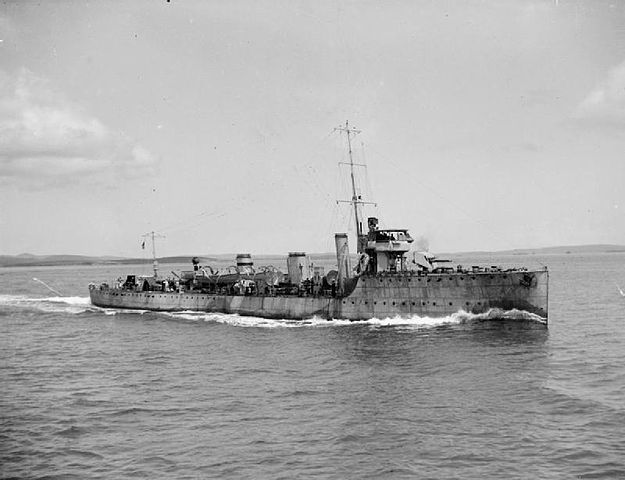
Redpole was from White, laid down 10 December 1909, launched 24 June 1910, commissioned February 1911. 2nd Destroyer Flotilla and on 26-28 May 1912, visited Aberystwyth, Wales, then back to Portsmouth. 16 April 1914, transferred to Plymouth. August 1914, Grand Fleet, deployed to Devonport. 28 August 1915 made a large anti-submarine patrol accompanied by battleships and cruisers.
13 November 1915, transferred to the Mediterranean for a proposed joint French-British operation in support of Serbia against Greece. Evntually the Greek government acquiesced to Allied demands on 23 November. She then joined the 5fth Destroyer Flotilla. On 20 January 1918 she was in Malta, served as escort, escorted the Australian torpedo boat Torrens rescue the Italian destroyer Benedetto Cairoli, damaged on 10 April. On 28 December 1918 Redpole briefly towed the white Russian destroyer Shchastlivyi from Sevastapol to Ismid, but she sank while on tow to Malta.
Decommissioned in Devonport, reserve, sold for breaking up 9 May 1921.
 HMS Rifleman
HMS Rifleman
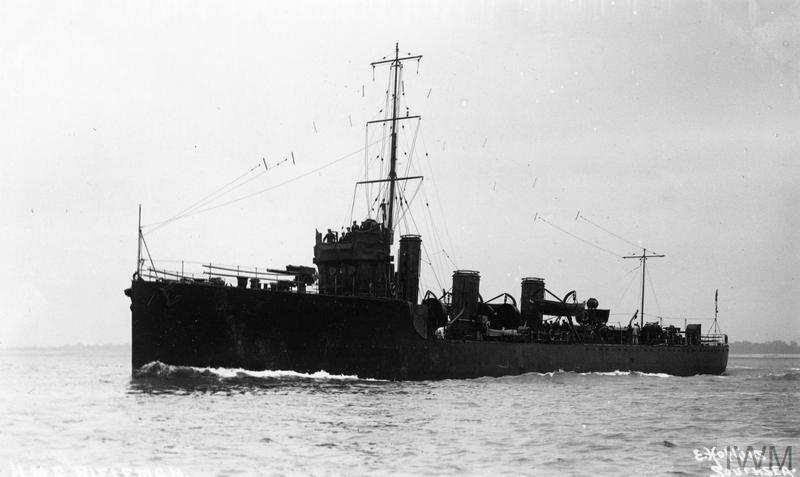
Rifleman was built at White, laid down on 21 December 1909, launched on 22 August 1910 and completed by March 1911. 2nd Destroyer Flotilla Home Fleet, samed issues as others in the 1911 Naval Manoeuvres, and from August 1914 Grand Fleet, Scapa Flow. 23 August 1914, collided with Comet. 12–13 November sailed with Larne to investigate sightings of submarines off the Outer Hebrides.
February 1915, patorlled the Irish sea in search of signalled U-21. Later, escorted battleship Conqueror to Liverpool, 14 February. Leaks repaired at Greenock. 22 May 1915, ran aground in fog, docked for repairs. January 1916, 5th Destroyer Flotilla, Med. 1 January 1917 earched for UB-47 which torpedoed RMS Ivernia off Cape Matapan en route to Alexandria. She rescued 650, taken to to Crete. On 15 April 1917 SS Cameronia from Marseilles to Alexandria, was attacked by U-33 torpedoed 150 miles (240 km) east of Malta. Refileman carried survivors to Suda.
20 January 1918, under refit at Gibraltar. Decom. Portsmouth May 1919. Sold for breaking up 9 May 1921.
 HMS Ruby
HMS Ruby
no pic
Ruby was from White, laid down 15 February 1910, launched 4 November 1910, completed 7 April 1911. 2nd Destroyer Flotilla, First Fleet and by August 1914, Grand Fleet, Scapa Flow. 23 August, reported a submarine. 18 September, patrolled Kent coast, Dover-Margate. 13-15 October, supported battleships in practice cruise. Devonport patrol, and February 1915 Barrow-in-Furness. Esscorted merchant ships in the Irish Sea. 7 May searched fir U-27 off the Butt of Lewis. 28 August, North Sea ASW sweep with battleships and cruisers. Attached to Admiral of Minesweeping, Devonport. 31 January 1917 escorted the ocean liner Calgarian with gold to Halifax. Later, rammed debris of a ship sunk by U-49, being damaged. 28 May 1917 after repairs patroled resulmed, and on 24 July, off Plymouth, detected and attacked an U-Boat with depth charges and well as off Lough Swilly on 7 August.
5th Destroyer Flotilla, Mediterranean Fleet. 20 January 1918, in Malta, undergoing refit. Patrolled the Otranto Barrage. November 1918 she was in the Black Sea in support of White Russians. 25 November she was in Sevastopol. 15 December she was in Ismid escorting the Russian destroyer Derzky. Ruby was placed in reserve at Nore, sold for breaking up 9 May 1921.
 HMS Sheldrake
HMS Sheldrake
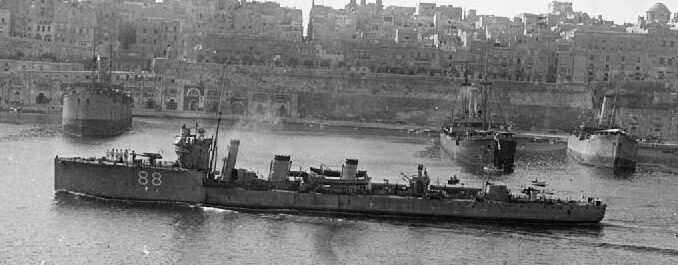
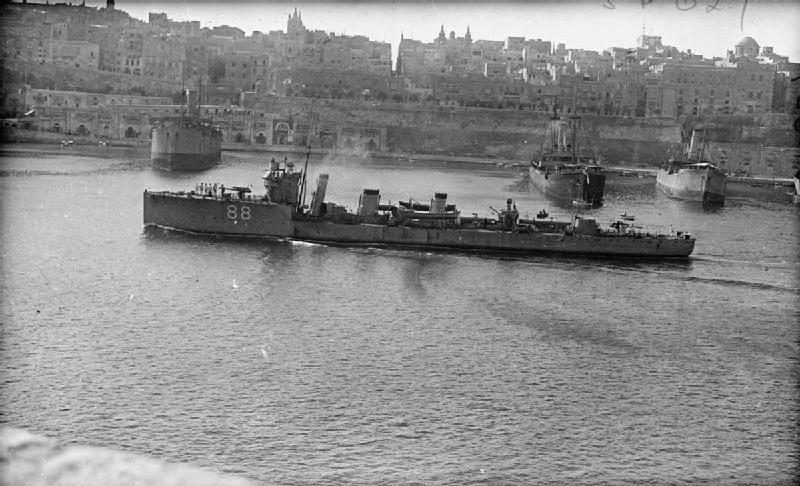
Sheldrake was from William Denny & Brothers, Dumbarton, laid down on 15 January 1910, launched on 18 January 1911, completed on 19 May 1911. 2nd Destroyer Flotilla in August 1914, Grand Fleet. 13-15 October, supported battleships practice cruise. Devonport for escort. December 1915, posted to Malta under Rear Admiral Arthur Limpus. Escorted troopship from Britain January 1916.
Assigned to the 5th Destroyer Flotilla. 23 March 1916, rescued 166 from horse fodder transport Minneapolis sunk by U-35. 27 April, trie to tow sloop HMS Nasturtium which it a mine. She escorted Ivernia with 2,500 troops from Alexandria to Marseilles 26-27 June. 2 June 1917, escorted the transport Minnetonka when U-35 approached, she drove her off. 20 January 1918, Aegean Squadron.
Post Armistice, reserve at the Nore. sold for breaking up 9 May 1921.
 HMS Staunch
HMS Staunch
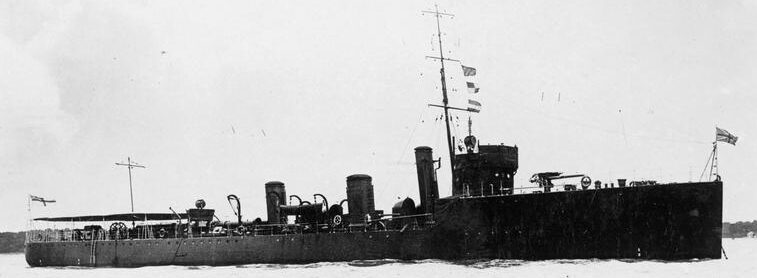
Staunch was from William Denny, laid down 15 January 1910, launched 29 October 1910 and completed in March 1911. Joined the 4th Destroyer Flotilla and from 5 August 1911, escorted the royal yacht Britannia at the Cowes Regatta, then 2nd Destroyer Flotilla and from August 1914, Grand Fleet, Scapa. 13-15 October supported battleships in training exercise. Deployed to Devonport. 28 August 1915, part of a large anti-submarine patrol with battleships and cruisers. Left Devonport 13 November for the Mediterranean 5th Destroyer Flotilla and sent to the support the Gallipoli campaign. She was part of the evacuation of 22,500 troops. 9 January 1916 she approached the hulks laying offshore and saves most of the Worcestershire Regiment.]
30 October 1917, she suppotted the monitor HMS Raglan bombarding troops Ottomn positions north of Gaza, later joined by HMS M15 and HMS M29, three French destroyers. They were based later at Deir al-Balah, Gaza, Palestine and on 10 November, U-38 (Lieutenant Hans Wendlandt) appriached at periscope dept, found a gap betweenanti-submarine nets and at 17:30, torpedoed M15 and Staunch, sinking both. 8 sailors aboard Staunch were killed. The rest were rescued or swam to shore.
Read More/Src
Books
Brown, David K. (2010). The Grand Fleet: Warship Design and Development 1906–1922. Barnsley, UK: Seaforth Publishing.
Cocker, Maurice (1983). Destroyers of the Royal Navy, 1893-1981. Ian Allan.
Dittmar, F.J.; Colledge, J.J. (1972). British Warships 1914–1919. Shepperton, UK: Ian Allan.
Friedman, Norman (2009). British Destroyers: From Earliest Days to the Second World War. Barnsley, UK
Gardiner, Robert; Gray, Randal, eds. (1985). Conway’s All The World’s Fighting Ships 1906–1921. Conway MP.
Manning, T.D. (1961). The British Destroyer. London: Putnam.
Moore, John (1990). Jane’s Fighting Ships of World War I. London: Studio.
Links
dreadnoughtproject.org Acorn_Class_Destroyer_(1910)
en.wikipedia.org/ Acorn-class_destroyer
navypedia.org/
commons.wikimedia.org Category:Acorn_class
navweaps.com/
Videos
Model Kits
Kombrig HMS-Larne-H-class-destroyer-1910 1:700
Modelkrak Japanese Destroyer “Sendan” Mks – J 046 1:700

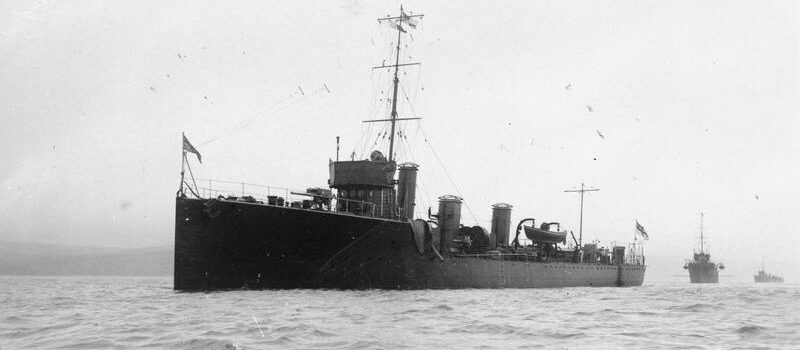
 Latest Facebook Entry -
Latest Facebook Entry -  X(Tweeter) Naval Encyclopedia's deck archive
X(Tweeter) Naval Encyclopedia's deck archive Instagram (@navalencyc)
Instagram (@navalencyc)





 French Navy
French Navy Royal Navy
Royal Navy Russian Navy
Russian Navy Armada Espanola
Armada Espanola Austrian Navy
Austrian Navy K.u.K. Kriegsmarine
K.u.K. Kriegsmarine Dansk Marine
Dansk Marine Nautiko Hellenon
Nautiko Hellenon Koninklije Marine 1870
Koninklije Marine 1870 Marinha do Brasil
Marinha do Brasil Osmanlı Donanması
Osmanlı Donanması Marina Do Peru
Marina Do Peru Marinha do Portugal
Marinha do Portugal Regia Marina 1870
Regia Marina 1870 Nihhon Kaigun 1870
Nihhon Kaigun 1870 Preußische Marine 1870
Preußische Marine 1870 Russkiy Flot 1870
Russkiy Flot 1870 Svenska marinen
Svenska marinen Søværnet
Søværnet Union Navy
Union Navy Confederate Navy
Confederate Navy Armada de Argentina
Armada de Argentina Imperial Chinese Navy
Imperial Chinese Navy Marinha do Portugal
Marinha do Portugal Mexico
Mexico Kaiserliche Marine
Kaiserliche Marine 1898 US Navy
1898 US Navy Sovietskiy Flot
Sovietskiy Flot Royal Canadian Navy
Royal Canadian Navy Royal Australian Navy
Royal Australian Navy RNZN Fleet
RNZN Fleet Chinese Navy 1937
Chinese Navy 1937 Kriegsmarine
Kriegsmarine Chilean Navy
Chilean Navy Danish Navy
Danish Navy Finnish Navy
Finnish Navy Hellenic Navy
Hellenic Navy Polish Navy
Polish Navy Romanian Navy
Romanian Navy Turkish Navy
Turkish Navy Royal Yugoslav Navy
Royal Yugoslav Navy Royal Thai Navy
Royal Thai Navy Minor Navies
Minor Navies Albania
Albania Austria
Austria Belgium
Belgium Columbia
Columbia Costa Rica
Costa Rica Cuba
Cuba Czechoslovakia
Czechoslovakia Dominican Republic
Dominican Republic Haiti
Haiti Hungary
Hungary Honduras
Honduras Estonia
Estonia Iceland
Iceland Eire
Eire Equador
Equador Iran
Iran Iraq
Iraq Latvia
Latvia Liberia
Liberia Lithuania
Lithuania Mandchukuo
Mandchukuo Morocco
Morocco Nicaragua
Nicaragua Persia
Persia San Salvador
San Salvador Sarawak
Sarawak Uruguay
Uruguay Venezuela
Venezuela Zanzibar
Zanzibar Warsaw Pact Navies
Warsaw Pact Navies Bulgaria
Bulgaria Hungary
Hungary

 Bundesmarine
Bundesmarine Dutch Navy
Dutch Navy Hellenic Navy
Hellenic Navy Marina Militare
Marina Militare Yugoslav Navy
Yugoslav Navy Chinese Navy
Chinese Navy Indian Navy
Indian Navy Indonesian Navy
Indonesian Navy JMSDF
JMSDF North Korean Navy
North Korean Navy Pakistani Navy
Pakistani Navy Philippines Navy
Philippines Navy ROKN
ROKN Rep. of Singapore Navy
Rep. of Singapore Navy Taiwanese Navy
Taiwanese Navy IDF Navy
IDF Navy Saudi Navy
Saudi Navy Royal New Zealand Navy
Royal New Zealand Navy Egyptian Navy
Egyptian Navy South African Navy
South African Navy






























 Ukrainian Navy
Ukrainian Navy dbodesign
dbodesign